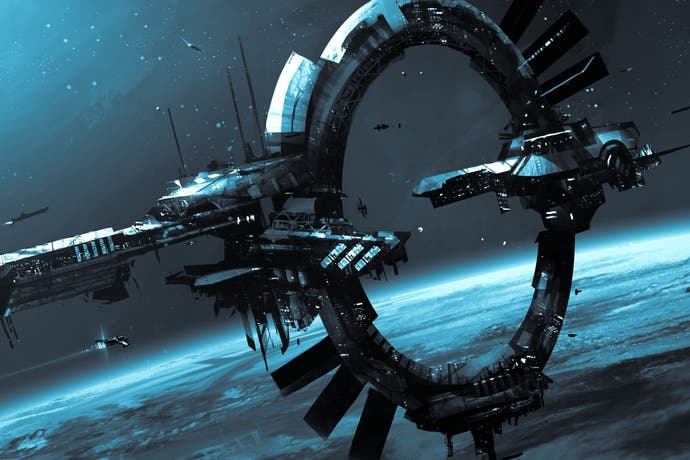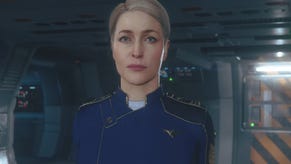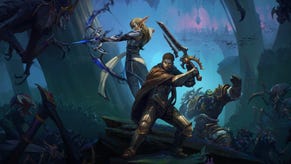Star Citizen, feature creep and money
"Now I'll answer those claims in one word: Bulls**t!"
PC space game Star Citizen has been in development for a while now. Some people are worried it's been in development too long. As the scope of the project grows and features are delayed, detractors accuse developer Chris Roberts and his company Cloud Imperium Games of succumbing to the dreaded "feature creep".
It's a sentiment that has grown in recent weeks following the delay of the first-person shooter portion of Star Citizen and news of a few departures of key members of the development team. And let's not forget the huge amount of money CIG has at its disposal to fuel development of Star Citizen: at the time of publication an incredible $85m of funding had been raised from just over 900,000 backers.
Couple this with the nature of Star Citizen's funding - much of its money comes from the sale of virtual ships despite the game still being in development - and the result is louder, and more vociferous, questions of Roberts' operation.
Now, Roberts has addressed this concern head on in a blog post published on the Roberts Space Industries website. In it, the developer rejects calls for CIG to scale back the scope of Star Citizen, insisting building as ambitious a game as possible is still the right course of action.
"There are people out there who are going to tell you that this is all a BAD THING," he said.
"That it's 'feature creep' and we should make a smaller, less impressive game for the sake of having it out more quickly or in order to meet artificial deadlines. Now I'll answer those claims in one word: Bulls**t!
"Star Citizen matters BECAUSE it is big, because it is a bold dream. It is something everyone else is scared to try. You didn't back Star Citizen because you want what you've seen before. You're here and reading this because we are willing to go big, to do the things that terrify publishers. You've trusted us with your money so we can build a game, not line our pockets.
"And we sure as hell didn't run this campaign so we could put that money in the bank, guarantee ourselves a profit and turn out some flimsy replica of a game I've made before. You went all in supporting us and we've gone all in making the game."
Star Citizen's production revolves around the creation and release of modules. The Hangar module, which lets you view your space ships in a futuristic garage of sorts, is live. Arena Commander, the spaceship dogfighting portion of the game, is also live.
Currently in development is Planetside (Star Citizen's social space), Squadron 42 (the game's story campaign), the aforementioned first-person shooter portion, now called Star Marine, and, bringing the game's parts together, the Persistent Universe module.
All these features are being built across four studios: Los Angeles, Austin, Wilmslow, UK and Frankfurt, Germany. CIG, like Star Citizen, is much bigger now than it was even just a few years ago, with over 250 people working on the game.
"Is Star Citizen today a bigger goal than I imagined in 2012? Absolutely. Is that a bad thing? Absolutely not: it's the whole damn point," Roberts continued.
"Will it take longer to deliver all this? Of course! When the scope changes, the amount of time it will take to deliver all the features naturally increases. This is something we are acutely aware of. How do we balance the mutually conflicting wants of the community; to have this hugely ambitious game, but not wait forever for it?
"Our answer is to embrace open development and share features and functionality that will go into the final game before everything is completed."
Roberts said his original plan was to share a multiplayer dogfighting alpha and then the beta of the game, which would have been just Squadron 42. But as every stretch goal was smashed and new stretch goals were met, "we had to find a way to keep people engaged while we were building this virtual universe".
"In today's 24/7 short attention-span world people don't have the patience to wait around for years," Roberts explained.
"This is why we decided on multiple modules: the Hangar, so you could first see your ships and walk around them in the manner you would in the final game, then Arena Commander, to allow people to get a taste and give feedback on the basic dogfight and flight mechanics."
Directly addressing concern over Star Marine's status, Roberts said it will be available "shortly". Not long after that's out, CIG will release the next level of Arena Commander, which will allow those with bigger ships to fly them with friends on maps that are closer in size to those expected to feature in the final game.
CIG will then launch aspects of the Persistent Universe. First, there will be plantside environments to explore, then you'll be able to transition to space and fly to another destination, and then after that to another system.
"I've said it countless times: my goal is to make the journey of Star Citizen's development worth the price of admission and the final game be the best bonus in the world," Roberts said.
The idea, Roberts said, is people will be able to play sections of Star Citizen without having to wait for everything to be done.
"It should be a win / win: you get to play a more limited version early, a version that is closer to the original goals, but you know the bigger, fuller featured version is coming - and the best bit is that you get it all for your initial pledge."
Accusations of feature creep, though, is a thorn Roberts has struggled to pluck from his side. He's faced growing concern from some backers who believe Star Citizen is perhaps growing too big - and too ambitious - for its own good.
"Is 'feature creep' a worry? Sure... it's always a worry, and we are well aware of it," Roberts countered.
"However, building the game to the stretch goals embraced and endorsed by the community is not feature creep! We made the decision to stop stretch goals at the end of last year. That was a hard choice to abandon one of the central tenets of crowdfunding projects, the idea that the sky is the limit... but it's one we felt we had to make for the better of the game.
"Today, we have a radical design that's like nothing else in the industry and we're building towards it every hour of every day. We count on the community's continued support to build the game to the high level that we set out to accomplish. Allowing independent authors to do more is the point of crowdfunding, and going beyond our limitations is the entire point of Star Citizen."
The more sceptical observers have gone as far as to label Star Citizen vaporware or a glorified tech demo. They wonder whether the game will ever launch, and suggest Roberts and co will be happy to continue to rake in cash from sales of virtual space ships that will never be playable.
"Arena Commander, which is still evolving, is a better looking and playing game than a lot of finished games out there," Roberts said.
"We are maintaining a live game and building one all at the same time. It's harder than just developing, as most companies that run online games will tell you, but it's worth it, both to ensure you get to experience features as soon as they are ready and to make a better game in the long run."
Roberts goes on to insist that CIG invests every dollar raised into the game, and points to its Terms of Service, which states an accounting would be published if the company ever had to stop development before delivering.
"With the progress and the funds we've raised this is no longer an issue, but quite obviously we wouldn't have provided for this clause, if we weren't using your funds very carefully for the development of Star Citizen," Roberts said.
All eyes now turn to Gamescom in August, where, Roberts said, CIG will show off "something special". The pressure's on.


















